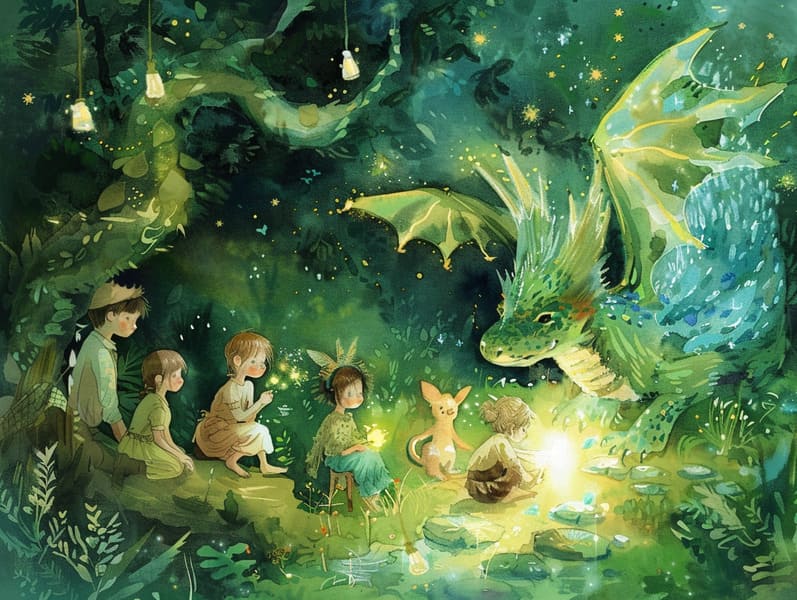The Creation of Famous Fairy Tales with Their Unending Wonder.
The Creation of Famous Fairy Tales with Their Unending Wonder.
Blog Article

Classic fairy tales have long histories. These narratives have been recounted from one generation to the next centuries before they were ever inscribed. They arose from a variety of traditions, including European traditions. They were initially conveyed among grown-ups, often carrying themes and messages pertaining to the societal norms and beliefs of the time.
The renowned Brothers Grimm, the two Grimm brothers, were among the first to gather many of these beloved narratives. Their collection, "Grimm's Children's Stories," included narratives like "Cinder Maid," "Little Brother and Little Sister," and "Snow-White and Rose-Red," which have since become pillars in the world of iconic fairy tales. Similarly, Andersen's delightful narratives, such as "The Little Mermaid," and "The Little Duckling," have enchanted hearts worldwide, guaranteeing their place in the pantheon of treasured fairy tales.
Despite their age, fairy tales remain as pertinent as ever, especially as bedtime stories for kids. These magical stories are now available in diverse formats, including vividly illustrated books, fantastical animations, and digital storybooks.
Their unwavering allure can be connected to several fascinating points:
Crucial Morals: Classic fairy tales often offer important moral lessons. Tales like "The Tale of the Boy Who Cried Wolf" teach the merit of truth, while "The Race of the Tortoise and the Hare" demonstrate the traits of determination and unassuming nature. These narratives offer young ones clear distinctions between moral and immoral, forming their moral compass in a soft yet important way.
Warmth and Understanding: Traditional fairy tales frequently illustrate heroes facing challenges and problems, urging young readers to empathize with their struggles and encourage their triumphs. For instance, "The Story of Beauty and the Beast" shows us the benefit of appreciating inner worth to perceive the true essence of a individual, nurturing awareness and comprehension.
Cultural Appreciation: Many fairy tales are imbued with the cultural contexts from which they sprang. Understanding these stories can provide informative snapshots into different societies, developing a sense of cultural understanding and perception.
Inventiveness and Fantasy: The fanciful elements in fairy tales—wizardry and magic—fire up children’s innovations. These fairy tales take readers to mythical realms, motivating inventive ideas and a sense of mystery that stays a lifetime.
Timeless fairy tales are not only enchanting but also pedagogical. They work as fascinating tools in enhancing various thinking and feeling skills in kids. When classic fairy tales are read aloud, they enhance verbal development by teaching new language and complicated sentence structures. This practice also strengthens auditory skills and attentiveness, as the young focus on every detail, eager to see what happens next.
Furthermore, analyzing the themes and characters of fairy tales can strengthen thought processes and thought processes. Young ones are taught to identify patterns, make predictions, and get cause and effect. These talks also boost little ones articulate their thoughts and feelings, advancing their emotional intelligence.
In today’s information age, the accessibility of digital storybooks has made these stories more within reach than ever. Online platforms and web apps supply extensive collections of children's fairy tales that can be explored or played anytime, anywhere. Fairy tales read aloud are particularly prevalent, presenting an interactive method for young readers to appreciate these magical stories. Sound books and read-out-loud videos guide characters and settings to life, often enhanced by bewitching music and music that intensify the tale journey.
The lasting allure of classic fairy tales lies in their ability to modify to new check here eras while staying true to their core messages. Contemporary updates of these tales often include more varied protagonists and modern settings, making them pertinent to today’s audience. However, the underlying themes of daring, kindness, and integrity remain unchanged, continuing to impact listeners of all ages.
Ancient fairy tales also offer a sense of security and recognition. They extend a orderly narrative with a recognizable beginning, middle, and end, often winding up with the solving of conflicts and the triumph of honesty over deceit. This assuredness can be encouraging for the young, imparting a sense of sturdiness in an inconstant world.
Old fairy tales continue to spellbind and guide new generations, maintaining their spell and pertinence in modern society. As children's bedtime stories, they bring a perfect blend of delight and instruction, cultivating moral values, empathy, and creativity. The abundance of digital storybooks and the favor of fairy tales voiced ensure that these classic tales remain within reach to new generations.
By holding onto and relating these stories, we continue to extol the rich tapestry of lore and cultural heritage. Whether you are viewing a vibrantly illustrated book, discovering a electronic collection, or listening on an read-aloud story, the beauty of children's fairy tales is always within reach. These tales remind us of the ageless ability of tales and its ability to bring us together across time and space.
Regardless if you are seeing a artistically illustrated book, perusing a cyber collection, or listening to an spoken story, the enchantment of bedtime fairy tales is always within reach.
These fairy tales point out of the eternal nature of fairy tales and its ability to unite us across epochs and places, creating a bond that fascinates and enlightens alike.